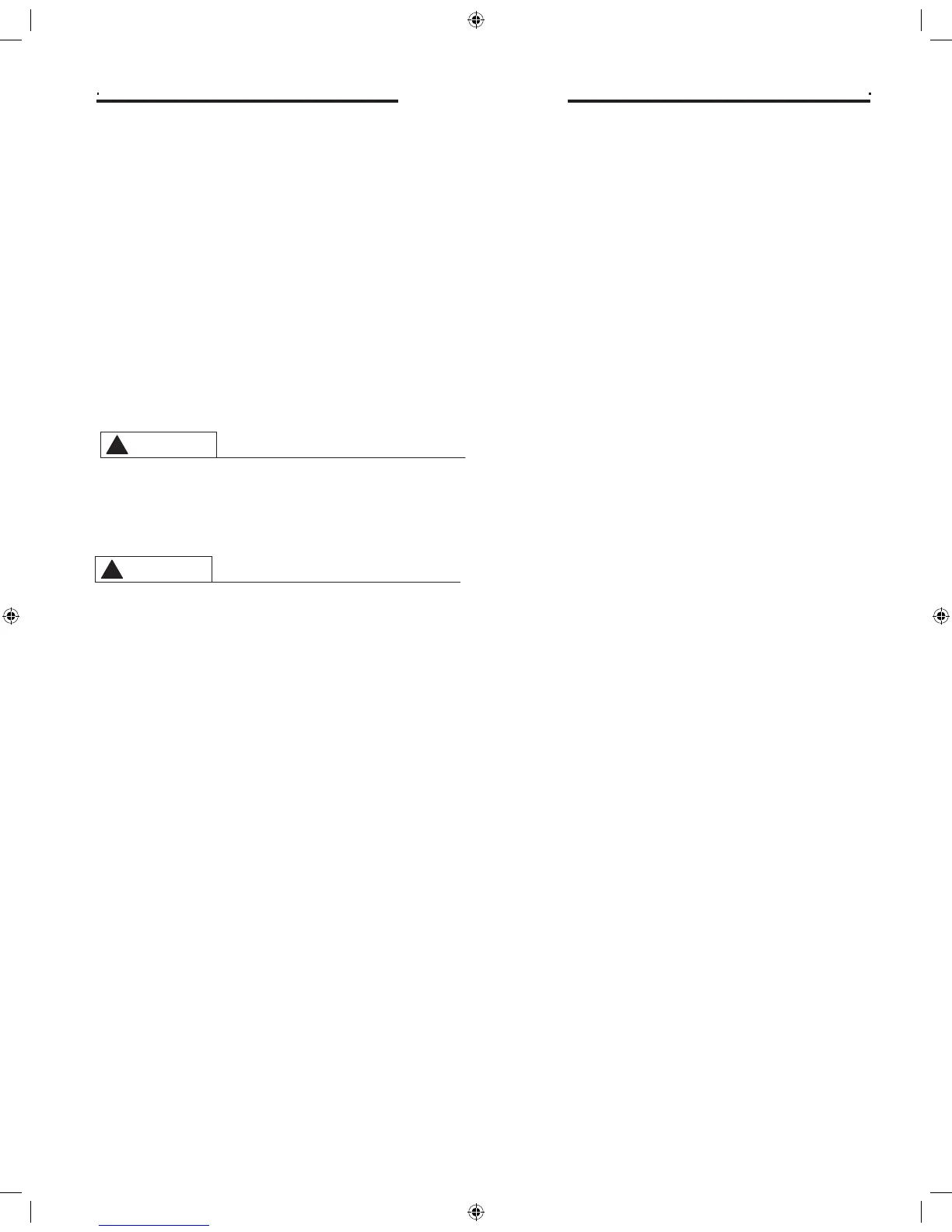27
Properly maintained, this water heater will provide years of dependable,
trouble free service. It is strongly suggested that a regular routine mainte-
nance program be established and followed by the owner. It is further rec-
ommended that a periodic inspection of the relief valve and venting system
should be made by service technicians qualified in gas appliance repair.
1. ROUTINE PREVENTIVE MAINTENANCE
A. PRESSURE SWITCH — Inspect the inlet to the pressure switch and
the tubing for debris or blockage. Clean out the tubing periodically to
prevent buildup of debris.
B COLLECTOR PAN —Remove any particles.
C. CONDENSATE TRAP — Check for blockages.
D. ELECTRICAL CONNECTIONS — Periodic inspection of all electrical
connections and wiring conditions.
Label all wires prior to disconnection when servicing con-
trols. Wiring errors can cause improper and dangerous op-
eration.
VERIFY PROPER OPERATION AFTER SERVICING !
Make certain all power to the water heater is turned
"OFF" before performing any maintenance or inspec-
tion work on this water heater.
Before manually operating the relief valve, make certain no
one will be exposed to the danger of coming in contact
with the hot water released by this valve. The water may be
hot enough to create a SCALD hazard. The water released
should be directed to a suitable drain to prevent injury or
damage.
NOTICE: If the temperature and pressure relief valve on the water
heater discharges periodically, this may be due to thermal expansion
in a “closed” water system. Contact the water supplier or local plumbing
inspector on how to correct this. DO NOT plug the relief valve outlet.
E. TANK— Good maintenance requires that the tank be cleaned of de-
posits. Unless the water supply is soft (0 to 5 grains hardness), scale
or lime deposits will accumulate in the tank. Hard water scale is de-
posited at an increasingly high rate in proportion to increased water
temperature. Accumulation of these deposits may reduce efficiency,
and shorten the life of the water heater.
Any new installation should have a tank inspection program set up
initially for frequent inspection. The first inspection should be within a
six month period. Once the scaling tendencies have been established,
the inspection program can be modified to suit the water conditions.
Cleaning should be performed if the scale has accumulated above the
drain valve opening.
A wet-dry shop vac with a nozzle fashioned from 1” and/or 3/4” poly-
ethylene pipe makes a good tool for scraping and removing scale.
TO CLEAN OR INSPECT TANK:
1. Shut off gas valve and drain tank.
2. Remove tank clean-out cover on jacket and with pocket knife cut
and remove a circular plug of insulation the full size of jacket open-
ing.
3. Loosen nut on seal plate assembly enough to twist yoke sideways.
Hold assembly securely and push inward, then remove from tank.
4. Remove as much built-up scale from flue tubes and tank bottom as
practical. Do not attempt to clean so thoroughly that the tool used
damages the glass lining.
5. Clean the seal plate and install a new gasket. Wipe clean the interior
surface of the tank that contacts the gasket. Reinstall the seal plate
and tighten in position. Fill tank with water and check for leaks. If
no leaks are found, install insulation plug and clean-out cover on
jacket and re-light the water heater.
If chemical lime dissolving cleaners are preferred, cautiously follow
the instructions supplied with the cleaner. DO NOT use a muriatic or
hydrochloric acid (HCl) base cleaner.
2. ANODE INSPECTION — The water supply in certain areas contains
very aggressive elements. In these areas, periodic inspection of the
anode is recommended to determine if replacement is necessary. The
anode(s) supplied in this water heater is slowly consumed , thereby
eliminating or minimizing corrosion and protecting the glass lined tank.
The anode(s) should be replaced when more than 6 inches (15 cm) of
core wire is exposed at either end.
3. SEASONAL OPERATION - If the water heater is to remain idle for an
extended period (60 days or more) the heater should be turned off. The
water heater and piping should be drained if they might be subjected
to freezing temperatures. It is recommended that the water heater's
operation is thoroughly checked (by a qualified service technician) be-
fore it is placed back in service. NOTICE: Refer to the Hydrogen Gas
caution notation on page 24.
F. VENTING SYSTEM — Inspect venting system at least yearly to make
certain the passageways are free and unobstructed, and that the vent
connector from the water heater’s blower assembly is properly posi-
tioned and securely attached. Remove any obstructions in vent con-
nector or vent terminal.
Maintenance
CAUTION

